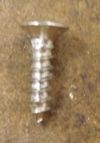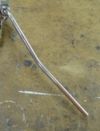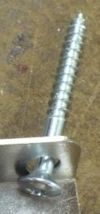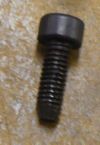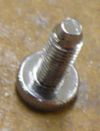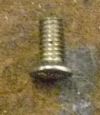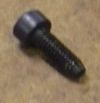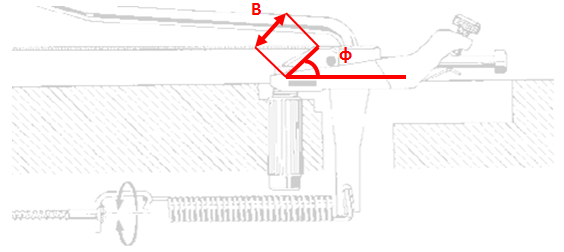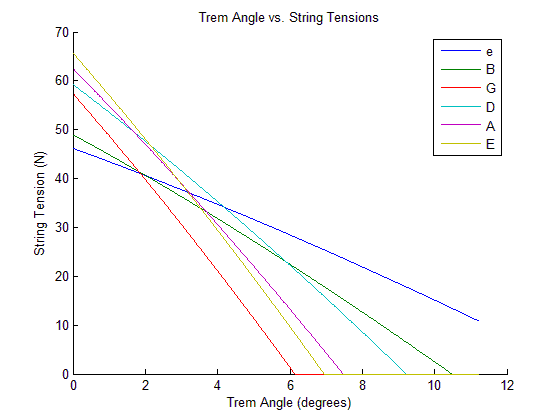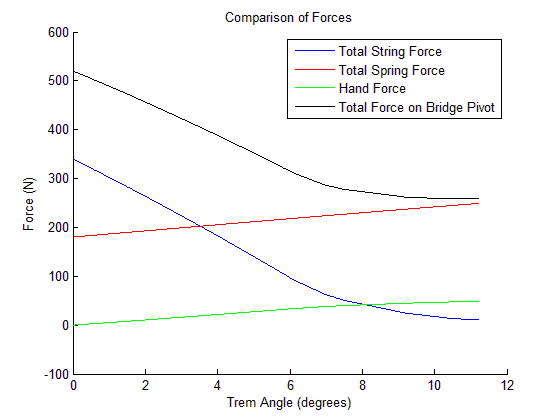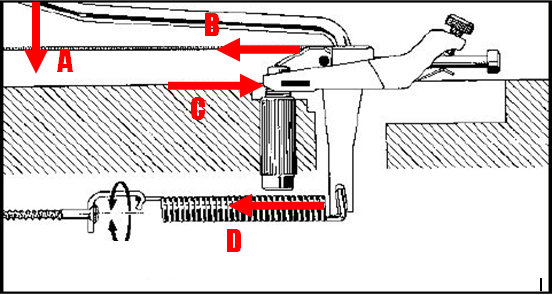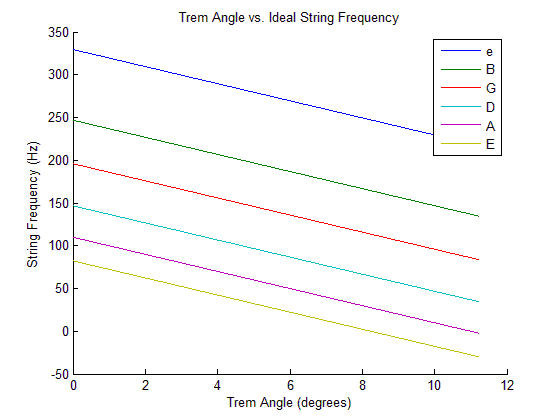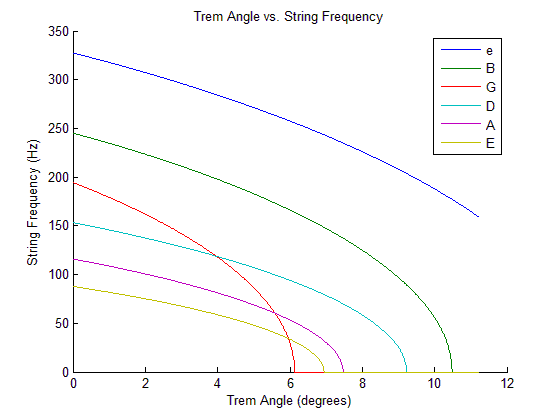Guitar bridge
From DDL Wiki
(→=Aaron Marks) |
|||
| Line 3: | Line 3: | ||
=Stakeholders and Needs= | =Stakeholders and Needs= | ||
| - | + | There are several primary stakeholders for this product, the manufacturers, suppliers, the novice users, and high-end users. There is enough variety in the market today that any major changes or improvements could be adopted competitively. With the two primary guitar bridges on the market, the Fender and the Floyd Rose, there is a wide spectrum of cost and quality. This can range from around a hundred dollars for a beginner's guitar to a few thousand for a high quality custom job. | |
| + | |||
| + | The major needs for manufacturers are within the design specifications. While a manufacturer can make the part to whatever their clients ask, an extra degree of precision can increase labor costs by an order of magnitude. The raw materials are all common and fairly low cost, mostly stainless steel and occasionally brass. Another issue for Manufacturers is assembly. The bridge itself is a moderately complex assembly with many parts to fit together, as well as fitting the bridge to the guitar and mounting the strings. One particular worry is the tension springs that act to counter balance the strings. These springs, located under the rear panel, are under very high tension and can cause injury to the user or damage to the product if an accident occurs during installation. Another issue is that the two common bridges require different mountings, meaning the parts are not readily interchangeable. | ||
| + | |||
| + | The suppliers primary concern is the saleability of the guitar and related products (amps, guitar straps, tuners, picks, ect.) and as a secondary concern the logistics of shipping the product from manufacturers to stores to customers. The product must fit the range of customers the supplier caters to (see below), and all of the related products should still be compatible with any new product on the market. | ||
| + | |||
| + | A novice user, for our purposes, is any user who does not play guitar at a professional level or for profit. While quality is important, cost is a significant limiting factor for their choices. Beginning guitarists will tend more towards a Fender bridge and overall lower quality of guitar, as the levels of precision for a high quality instrument will not have a pronounced effect unless the user has enough skill. | ||
| + | |||
| + | High-end users are professional musicians who will invest significantly more into the quality of their instruments, and for whom cost is less of an issue. These users will almost all use a Floyd rose bridge, (or in some cases an electronic self-tuning guitar), high quality guitar components, and ofter even pay a large sum for custom detailing work. For some musicians it is common practice to have several guitars on hand and an assistant who will re-tune the guitars after each song. | ||
=Use of the Current Design= | =Use of the Current Design= | ||
| - | + | The primary function of a guitar bridge is to securely mount and elevate the guitar strings. It must be able to withstand high tension forces and vibrations while keeping a consistent tension in all of the springs. For electric guitars, there is the added function of the tremolo, which moves the guitar bridge and changes the tension in the springs. This produces a long wavering sound used in many performances. | |
| + | |||
| + | There are two primary designs among guitar bridges. The first is the classic Fender model, a simple bridge developed in the 1940's which locks the springs in place and has a tremolo bar to deflect the bridge and alter the pitch of the strings. An improvement upon the Fender bridge is the Floyd Rose, developed in 1977. it features a floating bridge which improves the range of motion while keeping the guitar in better tune. | ||
=How the Current Design Functions= | =How the Current Design Functions= | ||
| - | + | Both the Fender and Floyd bridges function in a very similar manner. The bridge holds the string in securely place to maintain tension. The tension can be adjusted with tuning knobs at the top of the guitar neck. The bridge is connected with a pivot at the top edge, with springs on the underside to counteract the tension from the guitar springs. A tremolo bar is attached to the bridge to alter the angle of the bridge, putting slack into the strings and changing their vibrations to alter the instrument's pitch. This slackening and tensioning of the springs has the problem of causing the instrument to come out of tune as the tremolo is used. There are two primary differences in function between the Fender and the Floyd Rose. The Floyd Rose has a greater freedom of motion, both in the amount of change that can be caused and the rate at which the tension changes. The Floyd Rose also has the benefit of keeping the strings in tune longer than the fender, as it's jointed mountings pull the strings while the Fender rotates the bridge out of plane. | |
=List of Parts with Functions and Illustrations= | =List of Parts with Functions and Illustrations= | ||
Revision as of 16:16, 21 September 2008
Contents |
Executive Summary
Executive Summary will go here. Assigned to Jeremy.
Stakeholders and Needs
There are several primary stakeholders for this product, the manufacturers, suppliers, the novice users, and high-end users. There is enough variety in the market today that any major changes or improvements could be adopted competitively. With the two primary guitar bridges on the market, the Fender and the Floyd Rose, there is a wide spectrum of cost and quality. This can range from around a hundred dollars for a beginner's guitar to a few thousand for a high quality custom job.
The major needs for manufacturers are within the design specifications. While a manufacturer can make the part to whatever their clients ask, an extra degree of precision can increase labor costs by an order of magnitude. The raw materials are all common and fairly low cost, mostly stainless steel and occasionally brass. Another issue for Manufacturers is assembly. The bridge itself is a moderately complex assembly with many parts to fit together, as well as fitting the bridge to the guitar and mounting the strings. One particular worry is the tension springs that act to counter balance the strings. These springs, located under the rear panel, are under very high tension and can cause injury to the user or damage to the product if an accident occurs during installation. Another issue is that the two common bridges require different mountings, meaning the parts are not readily interchangeable.
The suppliers primary concern is the saleability of the guitar and related products (amps, guitar straps, tuners, picks, ect.) and as a secondary concern the logistics of shipping the product from manufacturers to stores to customers. The product must fit the range of customers the supplier caters to (see below), and all of the related products should still be compatible with any new product on the market.
A novice user, for our purposes, is any user who does not play guitar at a professional level or for profit. While quality is important, cost is a significant limiting factor for their choices. Beginning guitarists will tend more towards a Fender bridge and overall lower quality of guitar, as the levels of precision for a high quality instrument will not have a pronounced effect unless the user has enough skill.
High-end users are professional musicians who will invest significantly more into the quality of their instruments, and for whom cost is less of an issue. These users will almost all use a Floyd rose bridge, (or in some cases an electronic self-tuning guitar), high quality guitar components, and ofter even pay a large sum for custom detailing work. For some musicians it is common practice to have several guitars on hand and an assistant who will re-tune the guitars after each song.
Use of the Current Design
The primary function of a guitar bridge is to securely mount and elevate the guitar strings. It must be able to withstand high tension forces and vibrations while keeping a consistent tension in all of the springs. For electric guitars, there is the added function of the tremolo, which moves the guitar bridge and changes the tension in the springs. This produces a long wavering sound used in many performances.
There are two primary designs among guitar bridges. The first is the classic Fender model, a simple bridge developed in the 1940's which locks the springs in place and has a tremolo bar to deflect the bridge and alter the pitch of the strings. An improvement upon the Fender bridge is the Floyd Rose, developed in 1977. it features a floating bridge which improves the range of motion while keeping the guitar in better tune.
How the Current Design Functions
Both the Fender and Floyd bridges function in a very similar manner. The bridge holds the string in securely place to maintain tension. The tension can be adjusted with tuning knobs at the top of the guitar neck. The bridge is connected with a pivot at the top edge, with springs on the underside to counteract the tension from the guitar springs. A tremolo bar is attached to the bridge to alter the angle of the bridge, putting slack into the strings and changing their vibrations to alter the instrument's pitch. This slackening and tensioning of the springs has the problem of causing the instrument to come out of tune as the tremolo is used. There are two primary differences in function between the Fender and the Floyd Rose. The Floyd Rose has a greater freedom of motion, both in the amount of change that can be caused and the rate at which the tension changes. The Floyd Rose also has the benefit of keeping the strings in tune longer than the fender, as it's jointed mountings pull the strings while the Fender rotates the bridge out of plane.
List of Parts with Functions and Illustrations
The guitar’s bridge assembly contains 18 parts, including two main components of the guitar, the neck and the body. The Floyd Rose bridge contains 12 components. Most parts in both assemblies were made out of metal, either steel or brass. These metal parts were for the most part cast, though some of the flat pieces like the spring in the Floyd Rose bridge were stamped. Casting would be a fairly cheap way to produce these metal parts, and in a guitar like the one we dissected, which is made to be low cost, price of manufacturing would be a major factor. In a more expensive guitar, it is likely that these pieces would have been machined, both because the number of guitars being manufactured is smaller, and also because the quality of the parts would be higher with the increased precision of machining, be it by hand, or CNC.
The majority of the parts in both bridges are made out of metal. This is at least partially because of the strength needed to withstand the forces placed on the strings, and the entire bridge. Certain pieces, like the strings themselves and the sustain block, are made the way they are to achieve certain acoustic properties. There are most likely many pieces of the bridge that could be made with a lighter metal, like aluminum, but this would change the acoustic properties of the guitar. Additionally, because the body is made of wood and the guitar is aimed at a low cost market to begin with, weight is likely not a factor given much weight when design decisions are made.
DFMA
Assigned to Jonathan.
FMEA
Assigned to Jonathan.
DFE
Assigned to Jonathan.
Mechanical Analysis
Summary of Quantitative Analysis
In our quantitative analysis, we chose to analyze the forces acting upon the bridge. As an offshoot of this, we were also able to analyze the effect of using the bridge on the pitch of the strings. We determined that although each of the components of the guitar bridge act in an easily predictable linear fashion, the complex combination of all the factors combine together into a very non-linear system. The main independent variable of our device is the angle that the bridge is depressed by the guitarist. We called this variable theta.
For our analysis, we used a simplified, but relatively accurate model of the guitar bridge. The Floyd Rose bridge is functionally very similar to our bridge model. The original Fender bridge has a number of design flaws which introduce large unpredictable changes to the forces on the strings, which we could not model easily. Consider our model a “best case scenario” for a pivoting bridge. Any tuning problems with our model would be exacerbated, not alleviated in a real world implementation.
Assumptions
1. The strings are fixed at both the bridge and the nut. Without this assumption, the unpredictable shifting of the strings at the tuners and ball-ends introduces additional tuning problems. The Floyd Rose bridge employ’s clamps at the bridge and nut which fix the strings.
2. Strings behave as steel linear springs. Strings are made of nickel steel alloys. Since the exact recipe for the steel is a closely guarded industry secret, we assumed the properties of the strings match that of standard stainless steel. The density of stainless steel is 7800 kg/m3 and the elastic modulus is 200 GPa.
3. The guitar neck and body do not deform. In a real guitar, the body and neck are made of wood, and deform under the tension of the strings. This deformation is very small, and we chose to ignore it for simplicity.
4. Small Angle Assumption. We meant this not in the trigonometric sense (sin(angle) = angle, and cos(angle) = 1), but in the sense that the bridge is only meant to function at relatively small values of theta. We assumed a maximum angle of 12 degrees. Beyond this angle, the the strings are all completely limp, and at some point, the bridge would break.
5. We assumed that the strings used are of the common “8-42” variety. The string diameters are 8, 11, 15, 22, 30, and 42 thousandths of an inch. The thickest three strings are thinner steel cores wrapped with wire, which provide increased linear mass without making the strings too stiff to vibrate.
| String | Diameter (inches) | Diameter (m) | Core Area (m^2) | Tension (N) | Pressure (Pa) | Deflection (mm) | Standard Tuning (Hz) | Linear Mass (kg/m) |
|---|---|---|---|---|---|---|---|---|
| e | 0.009 | 0.000229 | 4.10e-8 | 46.1 | 1.13e9 | 5.63 | 329.6 | 0.0001673 |
| B | 0.011 | 0.000279 | 6.13e-8 | 49.0 | 7.99e8 | 3.99 | 246.9 | 0.0003163 |
| G | 0.016 | 0.000406 | 12.97e-8 | 57.4 | 4.42e8 | 2.21 | 196 | 0.000588072 |
| D | 0.024 | 0.000330 | 8.56e-8 | 59.3 | 6.93e8 | 3.46 | 146.8 | 0.001084068 |
| A | 0.032 | 0.000381 | 11.40e-8 | 62.5 | 5.48e8 | 2.74 | 110 | 0.002033498 |
| E | 0.042 | 0.000406 | 12.97e-8 | 65.7 | .07e8 | 2.53 | 82.4 | 0.003809595 |
Table 1: Properties Assumed (or calculated) of Guitar Strings
Figure 1: The Simplified Guitar Model Used for Analysis
Figure 2: Close Up of Guitar Bridge with Assumptions for Analysis
| Symbol | Definition | Value |
|---|---|---|
| L | Length fo the guitar scale, from the nut to the bridge pivot. | 25 inches, or 0.635 meters |
| B | The length of hte bridge from the pivot point to the point where the strings make contact with the bridge. | 3/8 of an inch, or 0.01346962 meters |
| S | The length of the string. | Variable function (function of θ) |
| φ | The "at rest" angle of the bridge | 45 degrees |
| θ | The additional, user supplied angle to the bridge. | Independent variable |
Table 2: Variable Definitions
Determining the String Tension
Each string on the guitar is made out of a very thin wire of nickel steel. The wire is either made of solid steel, or a solid steel core wrapped in another coil of steel wire. This wrapping allows the string to have a relatively high mass, while remaining flexible, as a solid string of the same thickness would be very hard to pluck. The wires can be viewed as springs, since under standard guitar tuning, the strings stretch an appreciable amount. Although each string can be viewed as an ideal spring, the combination of the tension forces of all six strings on the bridge is a non-linear function when compared to the angle of the tremolo.
One cause of this non-linearity is the fact that for any string, its tension vs. bridge angle function is a piecewise function. The tension in the string decreases linearly as the bridge angle increases, but when the tension reaches zero, the string does not compress like an ideal spring would. Instead, the tension remains zero. When you add together all six string functions, the resulting total plots as a curve, not a straight line.
Figure 3: Trem Angle vs. String Tension
Derivation
The strings behave as springs. Therefore, we will use Hooke’s spring law to determine the tension.
Where F is the spring force, k is the spring constant, and x is the stretch or compression of the spring. To determine the force of a spring in preexisting tension, we can add a constant to the format:
Substituting the appropriate variables for the guitar problem gives us this equation.
T0 is the tension of the guitar strings in standard tuning.
kstring is the string constant of the string.
S(0) is the neutral length of the string.
S(θ) is the length of the strings when the bridge is at angle θ.
Further deviation from the expected linear result is caused by effect of the string diameter on the rotation of the bridge. The bridge can be idealized as a pulley, around which the string is wrapped. When the pulley turns, the string is wound or unwound. Each string is not infinitely thin, so the radius of the pulley is different for each string. Therefore, the uniform rotation of the bridge allows a different amount of additional slack for each string.
Figure 4: String Radius's Effect on Tuning
Forces and Moments
Overall, the predictions of our mathematical model match very closely our hands on experience with the guitar bridge. The mathematical model predicts a force of around 10 pounds to depress the bridge appreciably, which the mathematical model backs up. This force seems to be an appropriate amount for ease of use, as too little force would allow the bridge to detune by accident, and too much force would make it too difficult to use. All the members of our group (guitarists and non-guitarists alike) felt that the amount of force required to operate the bridge was appropriate. The forces in the springs, which serve to create a counter-force to that of the strings, was lower than we expected, being less than ½ the force of the strings when the bridge is in its neutral position. When dissecting the guitar, we found removal of these springs to be quite difficult, and originally attributed it to high tension in the springs. This initial impression seems to be incorrect, as each spring is under only 15 lbs of tension. The bridge pivot serves as the mounting point and pivot for the guitar bridge. As such, it is the location where large forces are most likely. This proved correct in our mathematical analysis. In its neutral position, the pivot had to provide 500 N of force, or almost 120lb. The area over which this force is provided is very small (a few square millimeters), meaning that the pressure there is astronomically high. Distributing this pressure would be a possible direction for this project to take, as the pivot point of the bridge is a frequent point of wear and breakage on guitars.
Figure 5: Comparison of Forces on the Guitar Bridge
Derivation
Figure 6: Diagram of Bridge with Forces
Image from http://www.jemsite.com/tech/1setup.htm#step1 , taken from Ibanez Guitar Setup Booklet
| Variable | Description |
|---|---|
| A | Hand Force (User pushing on the lever) |
| B | String Tension |
| C | Pivot Force (at the mounting point) |
| D | Spring Tension |
Table 3: Force Definitions
The sum of the forces on the bridge can be expressed as such:
The sum of the moments on the bridge, summed around the pivot point, is as follows:
Where hbridge is 1”, lhandle is 5 ¾”, measured from the guitar.
String Frequency
An ideal guitar bridge would allow a guitarist to detune his guitar musically. This would mean that each string’s fundamental frequency would retain a linear relationship with the other strings. Such a bridge would have a frequency vs. bridge rotation graph similar to this one:
Figure 7: Ideal Angle vs. Frequency Graph
Using our mathematical model, we calculated the response of an actual guitar bridge, which looks like this:
Figure 8: Actual Angle vs. Frequency Graph
This graph shows that not only do the strings not behave linearly, but they also do not maintain a linear relationship to each other. This effect is especially noticeable on the G string of the guitar, which detunes much faster than the other strings. In practical terms, this means that the guitarist is not able to play chords when using the tremolo bridge of the guitar, as the strings no longer are in the same tune, so playing two of them together will sound dissonant. This limits the guitarist to only using the tremolo bridge for playing single notes, or chaotic dissonant noises. Being able to play chords and detune them musically would open up many musical possibilities currently not available to guitarists.
Derivation
In order to determine the frequency of the string, we need to know the length of the string as a function of the position of the bridge.
The length of the string is actually a use of the Pythagorean theorem, as can be seen in the illustration of our guitar model, the string is the hypotenuse of a triangle with sides formed by the guitar body, and the bridge. The height of the triangle is a function of the sine of angle of the bridge, and the thickness of the string. The length of the triangle is the sum of the length of the body, and the cosine of the angle of the bridge. We need to determine the linear mass of the string. The linear mass is the mass per length of string.
For the solid strings, this is easy to determine. For the wound strings, the linear mass is harder to determine. I used this formula, found at http://terrydownsmusic.com/technotes/StringGauges/STRINGS.HTM to determine the corrective coefficient to get the correct linear mass.
Where d0 is the total diameter of the string, and dcore is the diameter of the solid metal core.
The equation for a vibrating string is as follows:
Substituting the correct variables for the guitar example, the frequency of the string is a function of the length of the string, the tension, the linear mass, and where necessary, the corrective coefficient for linear mass. Note that for solid strings, the corrective coefficient is equal to 1.
Since S and T are actually functions of θ, the equation for frequency can be written in this form:
Using the equation and the string properties from Table 1, we were able to create the graph seen above.
Conclusion
Through our analysis, we discovered several things that will be useful to our future task redesigning the guitar bridge.
Firstly, the musicality of the strings when the bridge is used is not very good. The strings to not stay in tune relative to each other at all. This is not a small problem, but a fundamental issue with the current "rotational" tremolo design.
Secondly, the force required by the user to activate the bridge is about 50 N maximum. This is a very reasonable number, and should be our goal for any alternative designs we consider. The force of the springs on the bridge is similarly reasonable, and is not a design problem. The only force that is worryingly large is the force at the pivot points. Since this force is concentrated into a very small area, it has the potential to fatigue the metal very quickly. We might chose to design a bridge with a larger contact area for this force, which would improve the reliability of the bridge.
Team Member Roles
To complete the project, our team met to figure out how to work together to complete the report. We decided that the best way for us to go about this was to first do the dissection, then discuss our findings. After we discussed our results extensively, we decided to split the different aspects of the report in to sections, and assign the sections to group members. While each group member had his own sections to work on, we remained in communication and offered or requested assistance as necessary. Finally, once a complete draft of the report was done, we each check the report over in its entirety and offered feedback to the other group members on their sections.
Below are listed the team members, their roles and report sections.
Michael Harrison
Product Use Analyst
Stakeholders and Needs, Use of the Current Design, How the Current Design Functions
Jonathan Kyle
Product Design Analyst
Aaron Marks
Parts Analyst
List of Parts with Functions and Illustrations
Jeremy Ozer
Quantitative Analyst, Team Record Keeper
Executive Summary, Quantitative Analysis, Team Member Roles
All
References
ALL GROUP MEMBERS: Please put whatever references you use here in bibliographical format.
Jeremy
1. http://terrydownsmusic.com/technotes/StringGauges/STRINGS.HTM
This site has lots of useful information on the mathematics of stringed instruments, guitars in particular.
2. http://www.jemsite.com/forums/f21/string-tension-charts-73846.html
This forum, frequented by professional guitar techinicans, has lots of information about strings and tensions.
3. http://www.efunda.com/materials/alloys/alloy_home/steels_properties.cfm
This site was my reference for the properties of steel.
4. http://en.wikipedia.org/wiki/Guitar_tunings#Standard_tuning
This site gave me the frequencies for standard guitar tuning.
